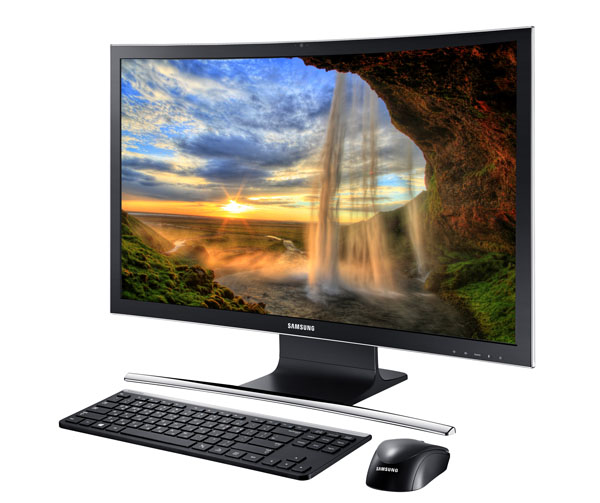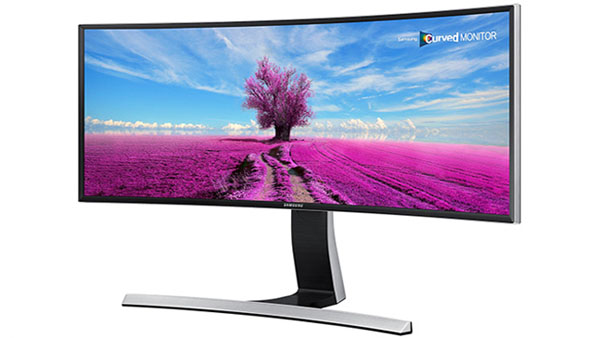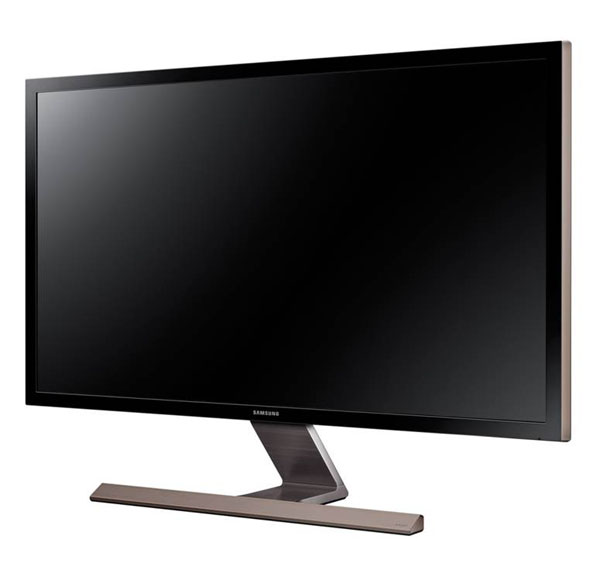Samsung's Curved ATIV One 7 AIO, UHD Monitors Hit CES
Curved monitors seem to be all the rage at CES this year, and Samsung is right in the mix with two entries – the SE790C display and ATIV One 7 all-in-one system.
The ATIV One 7 is built around a 27-inch curved VA panel running at a 1920 x 1080 resolution. The built-in PC runs on an Intel Core i5 5200U at 2.2 GHz with integrated Intel HD 5500 graphics. System memory is 8 GB and storage is provided by a 1 TB 5400 rpm hard disk. You also get a 1080p webcam and two 10-watt stereo speakers with HD Audio and simulated Dolby surround sound.
From what we've seen so far, the curved aspect works best in a 21:9 display (which is detailed below), but the extra sense of immersion is there in the 16:9 ratio, just not as prominently. Though Samsung doesn't specify the panel type here, we believe it's a VA part like the one used in HP's S270c and Pavilion 27c monitors. VA offers the superior viewing angles and uniformity of IPS with around double the contrast. We've reviewed one such panel, BenQ's BL3200PT and found it far outdistanced the competition in contrast performance.
The ATIV One 7 ships in Q1 2015 for $1300.
If you want a 27-inch curved monitor but aren't interested in the all-in-one ATIV shown above, Samsung is also offering the display alone.
Panel specs are the same as the ATIV One 7. You don't get the fancy speakers, but otherwise it offers the same 300cd/m2 brightness and excellent VA-provided contrast performance. Shipping in March, the 27-inch SE790C will carry an MSRP of $700.
Not to be outdone by HP and LG, Samsung is also offering a 34-inch curved screen in the 21:9 ultra-wide format.
Get Tom's Hardware's best news and in-depth reviews, straight to your inbox.
The SE790c is similar to LG's 34UC97 and HP's Z34c/Envy 34c twins. A 3440 x 2160 resolution VA panel with 300cd/m2 brightness is used as the core part. Native color is 8-bits per pixel in the sRGB color gamut with a panel response of four milliseconds. Inputs include one DisplayPort and two HDMI connectors. LG is still the only company to cater to Mac users with its Thunderbolt ports as seen on the 34UM97 and 34UC97.
Features unique to Samsung include a Game Mode and MagicBright option. We've seen these on the Ultra HD UD590 28-inch screen, which will be the subject of an upcoming review here at Tom's Hardware. The Game Mode increases panel response and reduces input lag by a measurable amount. It also locks the monitor into fixed brightness, contrast and color settings. MagicBright offers three extra picture modes if you don't want to calibrate – Standard, Cinema and Dynamic Contrast. In our experience, their use is a matter of personal preference. For those who want to tweak, we recommend the Custom mode.
The benefits of the ultra-wide aspect become more obvious when you actually see one in person. Photos just don't do these monitors justice. The 21:9 screens allow most of the functionality of multiple monitors without bezel lines to interrupt the image. You will also use less desktop space than that taken up by two 24-inch displays. Both the physical and pixel height of a 34-inch ultra-wide are equal to that of a 27-inch QHD monitor. Pixel density is therefore the same at 109 ppi; an ideal amount for Windows and gaming.
The SE790C ultra-wide monitor is available now for a $1200 MSRP.
Samsung has already brought us an excellent Ultra HD display in the form of the U28D590D. It will be seen in detail in an upcoming Tom's Hardware review, but in the meantime, a new update has been announced.
The UE590 has the same panel specs as the UD590 – 370cd/m2 brightness in a 28-inch TN format with 1 millisecond panel response and a 10-bit color depth. The only difference we can see is the HDMI ports are now version 2.0. That means if you have an appropriate video card, you can connect the UE590 via HDMI and see its full 3840 x 2160 resolution at a 60 Hz refresh rate. HDMI 1.4 only allows UHD pixel counts at 30 Hz, which is a major limitation for computer users.
Bringing on a second connection option for UHD signals is a nice upgrade, but what we're really anxious to see is more IPS panels in this high-pixel-density format. TN is a great way to keep prices low, but ultimately IPS and VA offer superior image quality. And after all, isn't that why we want more resolution?
The UE590 ships in March at an MSRP of $600.
Follow us @tomshardware, on Facebook and on Google+.

Christian Eberle is a Contributing Editor for Tom's Hardware US. He's a veteran reviewer of A/V equipment, specializing in monitors. Christian began his obsession with tech when he built his first PC in 1991, a 286 running DOS 3.0 at a blazing 12MHz. In 2006, he undertook training from the Imaging Science Foundation in video calibration and testing and thus started a passion for precise imaging that persists to this day. He is also a professional musician with a degree from the New England Conservatory as a classical bassoonist which he used to good effect as a performer with the West Point Army Band from 1987 to 2013. He enjoys watching movies and listening to high-end audio in his custom-built home theater and can be seen riding trails near his home on a race-ready ICE VTX recumbent trike. Christian enjoys the endless summer in Florida where he lives with his wife and Chihuahua and plays with orchestras around the state.
-
ceberle Reply14983144 said:You sure these 34" 21:9 monitors aren't 3440 x 1440?
3440 x 2160 would be 16:10.
You are correct, it should be 3440x1440.
-Christian-



